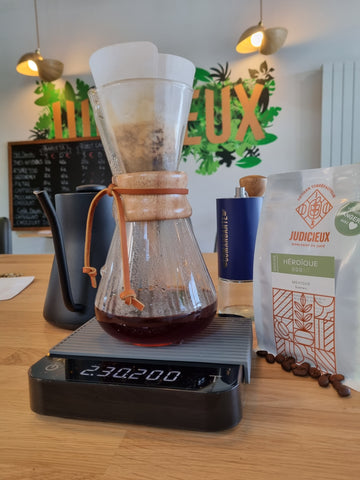SPECIALTY COFFEE
Synthetic :
Specialty coffee is part of a global movement that started in the United States around the 2000s before arriving in Paris in the early 2010s. Under the aegis of the SCA, SPECIALTY COFFEE ASSOCIATION, based in California, this movement defends the quality of coffee and aims to make the sector more sustainable and fairer. When we talk about specialty coffee we also talk about third wave coffee. JUDICIEUX, roaster in ANGERS, launched on this wave.

CHEMEX: TYPICAL PREPARATION METHOD OF SPECIALTY COFFEE
Coffee: successive waves:
The first wave of coffee , which was in fact a tidal wave, corresponds to the explosion of world coffee consumption, to its conquest of the world. It took place during the 19th and the beginning of the 21st century, favored by the improvement of transport conditions, the creation of scholarships and the search, in the United States, for a substitute for tea, symbol of the British oppressor. The coffee market became a mass production market .
The creation of vacuum packaging at the turn of the 20th century by improving preservation, allowed coffee to reach the most remote regions of the globe, but it distanced customers from roasters and thus from history and origin. coffees consumed. We agree: coffee is a seed from a fruit called a cherry: red when ripe, oblong and smooth like a grape.
The invention of instant coffee at the same time promoted coffee as a beverage made more to stimulate the senses than to tantalize the taste buds. Mass-produced coffee had become cheap, but infamous , undrinkable without strong milk and/or sugar.
The second wave of coffee was a reaction to the collapse of prices and product quality . It started in the 1960s in California. A few enthusiasts refocused attention on the origin of the coffees, the best roasting methods. The human aspect of coffee production was reconsidered with efforts made for better remuneration of producers. This is how the STARBUCKS phenomenon was born. Over the years and the expansion of this type of coffee shop chain, the initial project was lost.
It is the third wave , called specialty coffee, which has taken up the torch to work to make coffee a pleasant, complex and refined drink . The establishments of the third wave are rather the fruit of the work of independent entrepreneurs and enthusiasts (we will cite for example and by chance, the JUDICIEUX project, roaster in ANGERS) than of conglomerates. The quality and specificities of each coffee are put back in the center of the cup. The origin is highlighted. Not just the country and region, but the plantation itself. Like a castle in Bordeaux, France . The factors influencing the quality of coffee are known: variety of coffee tree, terroirs, altitude, shade, post-harvest processes.

a very nice boutique workshop, come and we will welcome you
Concretely, specialty coffee on the producer side:
On the producers' side, it is the possibility of being freed from the coffee exchange . The objective is no longer to make volume to compensate for an indecent price, but to aim for the very good, even the exceptional to attract the attention of roasters and sell, if possible directly, its coffee 2 times, 5 times , 10 times more expensive.
And what is needed to make good coffee: a lot of things and first of all energy and solid knowledge, at least empirical, in agronomy.
It is necessary to choose a variety adapted to its soil . As often, the search for yield and quality are contradictory: the slower the coffee cherry ripens, the higher the intensity of the organoleptic qualities. This is the reason why ETHIOPIAN coffees, appreciated by connoisseurs as real nuggets, are grown at high altitude and under shade (forest coffee or garden coffee protected by the broad leaves of Abyssinian banana trees). We cannot advise you enough here to taste our GRAAL .
The coffee tree is a fruit tree, so the art of pruning is also involved in order to promote the growth, development and sweetness of the fruits.
And what does the coffee tree eat? Well, it is not against a little fertilizer, but be careful not too much: an excess of nitrogen increases the caffeine content and the bitterness of the drink. The cheapest and probably not the least effective is to bring home-made compost with waste from coffee production (and yes, we only keep the seeds/coffee beans) the rest of the fruit, the waste from the pruning can return to enrich the soil.
Growing coffee therefore requires experience and expertise, and the care and attention that goes into it translates into improved quality – at the expense of low production costs. But the work is almost just beginning, because now it is a question of harvesting and recovering the grains contained in the cherries.

a producer met during a trip to Ethiopia, very proud to show us the operational schedule of his farm
Making a specialty coffee involves picking only the ripe cherries, which involves manual and careful picking and the need to go over each coffee tree several times; indeed, the cherries do not reach maturity all at the same time. Once the cherries have been harvested, they must be quickly transported to the area where they will be processed in order to avoid wild fermentation. There, different processes can be implemented to ensure an additional sorting of the cherries and to ensure the pulping: extraction of the beans from the coffee cherry. At JUDICIEUX, a roaster in ANGERS, we prefer the NATURE or dry method. It is the most extensive, therefore the least practiced, but it offers the advantage of avoiding very high water consumption. Once the green coffee beans have been collected, they have to be sorted manually to exclude all the defective beans: it's a titanic task.

We came across this panel in the GUJI region, intended for seasonal workers who came for the harvest; reds, only reds!

green coffee sorting workshop, in the shade, in the YRGACHEFFE region
Indeed, for a green coffee to be considered a specialty coffee : its physical qualities are assessed according to a specific protocol and criteria. The level of requirement is very high: a sample of 350 g of coffee is made and observed. No class 1 defect must be observed (for example presence of foreign bodies, black grains, significant degradation linked to mold or insect attack) and class 2 defects must be very limited (broken grain , immature, withered…)
And on the roaster side, what does specialty coffee roasting mean?
Roasting specialty coffee requires knowledge, rigor and attention . The producers have done an enormous job, it is up to the roaster to magnify it with the appropriate equipment (for JUDICIEUX, a roaster in ANGERS, it is a DIEDRICH IR 12,) and an approach allowing excellence to be achieved.

output of roasted coffee on our roaster
The physico-chemical parameters of green coffee are analyzed before roasting: density, humidity. Thanks to these parameters, knowing the coffee production conditions and depending on the chosen objective, a recipe, called the roasting profile, is determined.
To implement this recipe, the specialty coffee roaster is equipped with probes. Connected to a computer, they make it possible to follow the evolution of the temperature at the key positions of the machine. The roasting parameters are adjusted regularly during the process to achieve the set objective.

roast profile
No good results without control: tasting. It is done according to a precise protocol determined by the SCA: it is cupping. Thanks to the recording of roasting data, the tasting will make it possible to adjust the following roastings: constantly putting the work back on the job!
Indeed, according to the SCA, for a roasted coffee to be considered a specialty coffee: the coffee is said to be specialty if it is assigned a tasting score greater than 80/100 by a Q-Grader. A Q grader is a person accredited and trained by the COFFEE QUALITY INSTITUTE to be able to accurately and consistently assess the quality of a coffee in accordance with the SCAA's cupping and grading standards and protocols.
C. LICHTLE 24-03-22

